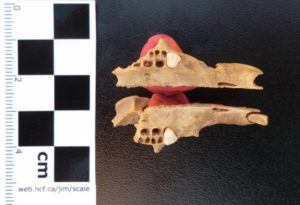Another example of why you should always hire a professional zooarchaeologist when you find animal bones on your site (in this case, the professional zooarchaeologist was Renee Walker):

Hart, John P., and Robert S. Feranec. 2019. The Dog That Wasn’t: An Historical Pig Burial on the Sixteenth-Century AD Klock Site, Fulton County, New York. Archaeology of Eastern North America 47:1-6.
Abstract. An articulated animal skeleton was found in a pit feature at the cal. sixteenth-century AD Klock site in Fulton County, New York during New York State Museum excavations in 1970. The skeleton was reported as a dog burial associated with the Native American occupation in Funk and Kuhn’s 2003 report on the site. Recent analysis indicates that the animal was a six-month-old domesticated pig. A radiocarbon date on the skeleton indicates the animal was most likely buried in the cal. nineteenth century AD, well after the Native American occupation of the site.



